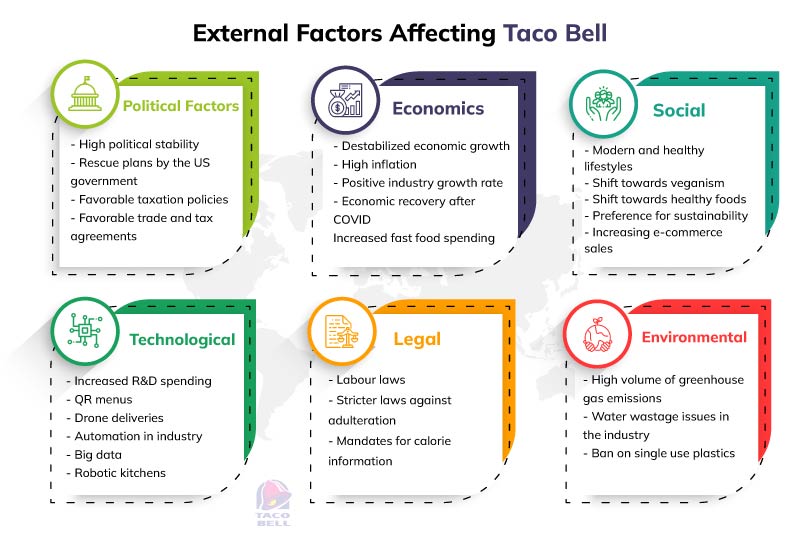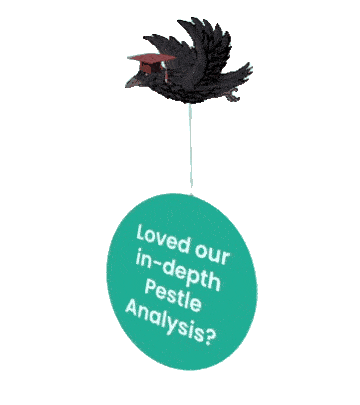Taco Bell Overview
Taco Bell is a fast-food chain popular for its renowned tacos as is visible in its name. Its other items like Nachos, Burritos, and Quesadillas along with others are also preferred. The company has a significant presence in the fast-food market with more than 7700 stores, most of them located just in the US. The stores have a high footfall and the company serves over 42 million customers a week.
This article presents a well-researched and conclusive PESTLE Analysis of Taco Bell as per the latest developments in the external business environment. This analysis delves deep into how Taco Bell’s future operations and strategic plans may change contingent on developments in the external business environment.
Table of Contents
A substantial and accurate PESLTE Analysis of Taco Bell

Political factors affecting Taco Bell
The US is highly stabilized in political terms and the government is favoring businesses through various schemes. The US also has various trade and tax agreements with various nations to facilitate corporations. To add, The federal government of the US recently passed the Restaurant Rescue Plan with a corpus of $28.6 billion wherein the QSR restaurants would be provided a maximum of $10 million for their loss due to the pandemic (PYMNTS, 2021). This would provide opportunities for the businesses to recover losses and maintain financial stability.
Further, the taxation policies in the country are favorable for businesses as is visible from the fact that recently there was a drastic reduction in the corporate tax from 35% to 21% to boost investments. However, many cities, for example, Minneapolis, Fair Haven, etc. have announced a ban on constructing drive-thrus in order to reduce litter, and carbon emissions and enhance walkability among pedestrians (Helmer, 2019). This would reduce the influx of busy customers and the decision would ultimately lead to a reduction in sales.
Besides, India is also one of the important markets for the fast-food industry. The country has immense opportunities because of various initiatives that governments are undertaking to boost the business environment. But the government is highly discouraging unhealthy food and going in this direction, the federal government of India has announced a ban on fast-food restaurants that are located near schools (Kaul, 2019). This can impact the sales of fast-food restaurants as youngsters are the major consumers. In addition, the government of India is planning to impose a fat tax on fast food items to discourage people from consuming fast food (TOI, 2022). If the fat tax is imposed, it would lead to an increase in the prices of the products due to which the customer base of the restaurants would get reduced.
Economic factors affecting Taco Bell
The US is growing at a rapid pace, the growth in 2021 was recorded at 5.7% which was the highest in almost 40 years. The positive growth signifies a potential opportunity for the companies to enhance their footprint. Further, the unemployment rate is hovering around the same mark. It was 3.9% in December and is expected to fall by a bit in 2022 to 3.8% and 3.5% in 2023 (Knoema, 2021). The stability in the unemployment figures can be a positive sign for the fast-food companies as more people would shift towards affordable products. The inflation rate in the US in 2021 crossed the mark of 7.5% because of disruption in the supplies of the products. The higher inflation rate would lead to an increase in the prices of products, hence reducing the affordability for many customers.
Further, India, one of the major markets for the fast-food industry, is expected to grow at 8.3% by the end of FY2021 and is expected to touch the level of 8.7% in 2022 (FY, 2022). The high numbers signify the positive outlook for the businesses in the country. But, the base rates set by the country’s federal bank have been hiked by 10 basis points recently, meaning that the rate of borrowing the money has increased which would increase the liability of the companies, hence they would not like to expand (ET, 2021).
The fast-food industry in the US is valued at $260 billion and is predicted to grow by 7.1% and reach $295 billion by 2022. In the coming years, the fast-food industry in the US is forecasted to grow at a CAGR of 4.10% to $660 billion between 2022 and 2026.
Social factors affecting Taco Bell
The consumption of fast food in the US is on the rise, especially among the millennials and generation Z. Close to 45% of people in the millennials category and 37% of people from generation Z category consume fast food on a daily basis (Fryar and Hughes, 2019). This trend poses a significant opportunity for QSR companies to enhance their business. Further, over 9.6 million people have started consuming a vegan diet over the last few years (Kirkwood, 2020). The rise in the veganism trend poses a significant opportunity for QSR companies to enhance their product offerings. For brands that are already popular among vegans, this trend hints at a massive opportunity. Moreover, people are now tech-savvy and find great convenience in ordering food online. Hence, the companies must ensure that they enhance the digital experience of their customers to make the most of the massive rise in online food deliveries. As per Expert Market Research, the online food delivery market in the US is expected to grow at a CAGR of 10.5 percent in the coming years. It is essential for companies to optimize their online promotional and distribution channels.
Besides, Indians too prefer online ordering of food and on average, a customer in the country orders food online around 3-4 times. Further, digital literacy is high in India with 110-120 million people having awareness of how to conduct online transactions. This signifies a huge growth opportunity for fast-food companies to aggressively venture into online platforms.
Technological factors affecting Taco Bell
The US government spends the highest on Research and Development in the world. It spent $157 billion in 2021 and the expenditure for 2022 is estimated to be $171 billion. On the other hand, India spent Rs. 851 crore in 2021 and the budget has been decreased to Rs. 812 crore for 2022. Further, various technologies are revolutionizing the way the QSR industry operates. For example, robots for taking orders and preparing food. Further, drones are being used for the delivery of parcels. In addition, self-service kiosks wherein the customers can order and pay through screens enhances the customer experience. Further, technologies like scan and learn wherein the customers can scan the menu from the phone and get to know about the food ingredients, and their nutritional value and can help customers in making informed and healthier food choices. Moreover, smart staff management systems can assist companies in understanding customer trends, online and in-store orders, and the number of staff required to provide appropriate customer service.
In India too, the companies are benefiting highly from a robust technological infrastructure. E-commerce technologies are widely growing in the QSR industry and technologies like QR menus, automated inventory management and live tracking of orders are becoming popular. To add, robotic kitchens, smart staff management systems, big data analytics, and machine learning-driven menus are changing the face of the industry.
Also, the foreign fast-food chains in India cannot sell beef products in alignment with the predominant religious beliefs in India. Hence, companies will have to look for attractive replacements to their beef products when looking to create a wide presence in India.
Legal factors affecting Taco Bell
As employment in the fast-food industry is booming, the government has announced new laws to be followed by restaurants. From now onwards, the employers cannot fire the workers immediately and they are required to provide multiple disciplinary warnings before terminating them. Further, the employers must provide the first opportunity to the laid-off employees if there is any vacant position in the restaurant (Porpora, 2021). This limits the freedom of the companies to employ labor on their own which may lower the efficiency as the companies might not be able to get a chance to hire more talented workers. Further, the US. Food and Drug Administration has made it mandatory for restaurants to display the calorie content of the items at the point of sale so that the customers can make informed decisions (Stewart & Morrison, 2015).
Besides, the Food Safety and Standards Authority of India is responsible for enforcing the food safety laws in India in accordance with the Food Safety and Standards Act which states that the food offered by the companies should be fit for human use and not adulterated. The law also regulates the conditions under which the food is prepared and enlists fines and imprisonments for various violations (Sahoo, 2019).
Environmental factors affecting Taco Bell
The fast-food industry contributes highly to greenhouse gas emissions through wastage of food, use of gas to heat the buildings, and consumption the meat on a large scale. Further, the fast-food industry uses single-use plastic for packaging and it is estimated that the industry wastes around 5800 gallons of water per day in the US alone and produces about 15% of the total greenhouse gas emissions. To resolve these issues, various environment-related policies have been formulated by the government including banning single-use plastic by the government of Oregon, New Mexico, and California. To add to the worries, the federal government of India has also announced a ban on single-use plastic from 2023. This would make the companies shift towards alternative packaging materials like paper which can increase the cost for the companies as they would have to change the supply chain totally.
The fast-food industry stands a high potential opportunity as the growth rate of people is declining and the level of employment is not rising much. This would make people shift towards low-cost food. But, businesses in India can suffer a setback as the government has banned the opening of restaurants near schools, and also the preference for more vegan food items signifies a threat for the restaurants whose food is mostly based on meat. Moreover, the fast-food industry consumes single-use plastic in high volume and the banning of plastic across the countries would raise the expenses of the companies as they would have to shift to alternate sources. Also, to learn about the internal strengths and weaknesses of the company, you can go through our diligent SWOT analysis of Taco Bell.
Recommended Readings
PESTLE Analysis of Chipotle Mexican Grill
PESTLE Analysis of Dunkin Donuts
References
Financial Express. (2021). Big rise in business positive pandemic takeaway for food delivery apps. www.financialexpress.com. Retrieved 2 April 2022, from https://www.financialexpress.com/industry/sme/big-rise-in-business-positive-pandemic-takeaway-for-food-delivery-apps/2198778/
HELMER, J. (2019). Why U.S. Cities Are Banning New Fast-Food Drive-Throughs. www.npr.org. Retrieved 2 April 2022, from https://www.npr.org/sections/thesalt/2019/10/10/765789694/why-u-s-cities-are-banning-new-fast-food-drive-throughs
Hindustan Times. (2019). Government issues draft regulation to ban junk food near schools. /www.hindustantimes.com. Retrieved 2 April 2022, from https://www.hindustantimes.com/india-news/govt-issues-draft-regulation-to-ban-junk-food-near-schools/story-AaGtO5ATw26fulgaxfNIsL.html
Porpora, T. (2021). New laws protecting fast food workers go into effect July 4: What you need to know. www.silive.com. Retrieved 2 April 2022, from https://www.silive.com/news/2021/07/new-laws-protecting-fast-food-workers-go-into-effect-july-4-what-you-need-to-know.html
The Economic Times. (2021). SBI base rate hike: Is this the start of the end of low interest rate regime?. economictimes.indiatimes.com. Retrieved 2 April 2022, from https://economictimes.indiatimes.com/wealth/save/good-news-for-fd-investors-bad-news-for-borrowers-is-this-the-start-of-the-end-of-low-interest-rate-regime/articleshow/88315917.cms?from=mdr.
Times of India. (2022). Government to impose tax on unhealthy food items to tackle obesity. imesofindia.indiatimes.com. Retrieved 2 April 2022, from https://timesofindia.indiatimes.com/life-style/food-news/government-to-impose-tax-on-unhealthy-food-items-to-tackle-obesity/photostory/89946430.cms

 Proof Reading
Proof Reading  Copy Writing
Copy Writing  Resume Writing
Resume Writing  Blogs
Blogs Guides
Guides SOP's
SOP's Student Resources
Student Resources Research Topics
Research Topics Login
Login Register
Register



